The Customer Experience Management Guide [Chapter 4]
Customer experience. It’s the latest marketing buzzword. But what does it mean for your business?
We’ve gone through the who, what, why. Now it’s time to focus on the how. Chapter 4 will take you through a four-phase approach you can start today to get your organization from chaos to cohesive marketing-driven customer experience. If you’re just jumping in, head back to Chapter 1 to learn the leading analyst perspectives and research on CX now and in the future.
From Chaos to Marketing-Driven Customer Experience
We’ve seen why disjointed customer experiences curtail revenue growth, and how customer experience maps and experience interlock solve that problem.
Now, let’s put these strategies into practice.
To get your organization from chaos the delivering an effective marketing-driven customer experience, use the following four-phased approach: (1) establish awareness of the problem and plan a solution, (2) gain visibility into the current state of customer experience and content across your organization, (3) align marketing initiatives, technology, people, and channels, and (4) optimize processes and experience interlock to drive impact and business growth.
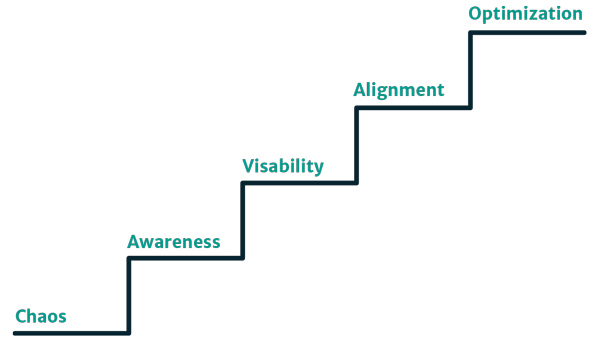
Phase 1: Awareness
Overcoming chaos in the customer journey involves several stakeholders from across the organization. Without first establishing awareness of the problem through data, metrics, and examples, strategies for establishing marketing-driven customer experiences often fail due to lack of buy-in. Here’s how to take the first step on the path to optimized customer experience.
Audit Current Content and Experiences
First, research the problem and quantify the impact a broken customer experience has on your organization by gathering data, metrics, and examples. Use statistics from industry analysts to prove urgency internally. Pull examples of disjointed messaging currently spread across your organization’s marketing channels, and present them as examples of confusing customer experience. Prove old messaging is still influencing customer journeys by pulling metrics like page views on blog posts, leads generated from white papers, or the number of active nurture campaigns using outdated messaging and disconnected topics.
Next, visualize this problem for internal stakeholders by auditing your content and mapping the current customer experience. Depending on the scope of your organization, a comprehensive audit may be an unrealistic first step. If this is the case, limit your audit to a single persona for a single product line at the pre-sale stage of the customer life cycle.
Start by identifying your content assets. Categorize them by persona, buying stage, and topic, and begin to cluster assets into experiences based on the specific questions they introduce or answer. As you collect content into experiences, document their question-and-conclusion sets.
You may end up with something that looks like this:
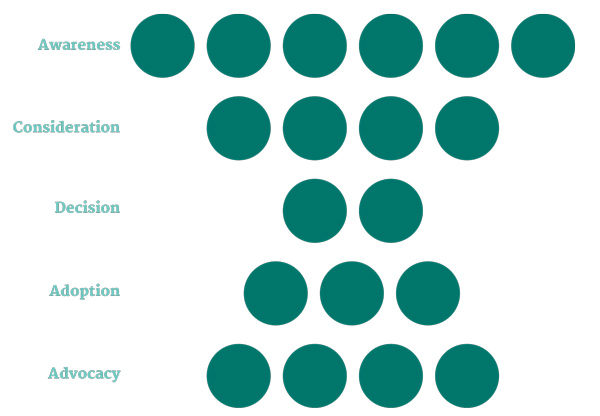
Each node, or circle, corresponds to an experience, which includes a set of assets.
Complete the following information for each experience:
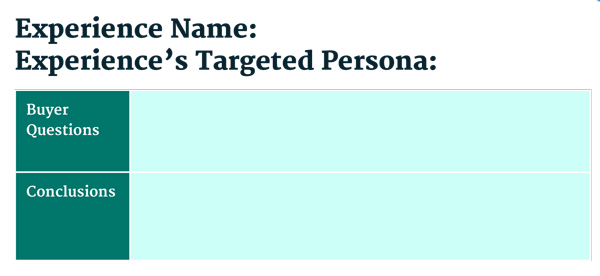
Next, assess the interlock between these experiences. Do the conclusions of a prior experience connect with the questions of a subsequent experience? Most B2B organizations will find gaps—and that’s okay. This will help you understand the scope of the problem, and gain the buy-in you need to fix it.
Mark each interlock by connecting the experiences on your map. It should look something like this:
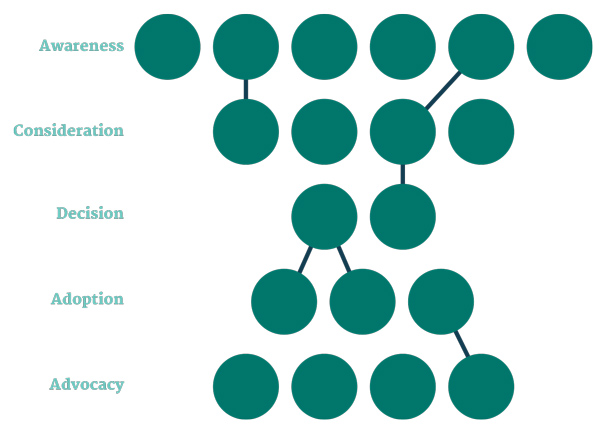
This will emphasize the magnitude of disconnect across the current customer experiences, and help to show the urgency of resolution.
Create a Plan to Move Forward
Next, provide a strategy for moving forward for addressing the issues you’ve uncovered.
Here’s an example to help you organize your strategy into specific phases, broken into three related initiatives:
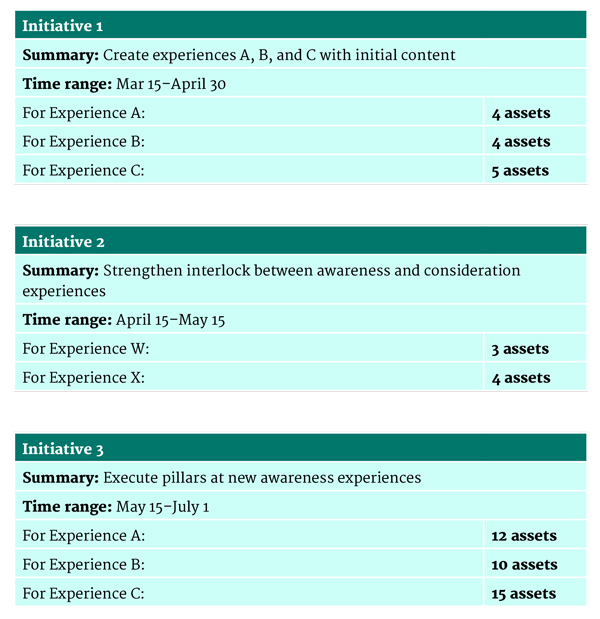
Remove Ineffective Experiences
As marketers, we often feel the pressure to always be adding more, more, more—particularly when it comes to content. But more content—particularly content that’s off-message and disconnected from other assets and the overall customer experience—can be detrimental, as it only serves to confuse the customer.
In large organizations, with content sprawled across many sites, microsites, and shared repositories, there is a sense that excessive content needs to be pruned back. But without a big-picture view of the entire customer experience and its corresponding assets, it’s nearly impossible to nail down which content to deactivate.
The customer experience map provides this big picture. As part of your solution strategy, make sure to include timelines for pruning outdated marketing content that no longer supports consistency and growth.
To do this, consider the two ways in which customers encounter content: either they discover it independently on the Internet, or an internal stakeholder finds the content and distributes it to the customer (e.g., a marketer includes an asset in an email campaign or a salesperson shares the asset with a buyer).
For self-encountered web content, discern if it’s inaccurate or not. If it’s inaccurate, it needs to be taken down or updated. If it’s not inaccurate, but is no longer promoting a relevant message, it can remain as long as it isn’t prominently linked to from one of the major points of entry within your web experience. The reason to keep, say, an outdated blog post, is that it might have SEO and referral-link value that you’d rather not lose by removing it completely.
For content distributed by internal stakeholders, you need to have tight control of the content approved for stakeholders to utilize. This is best done through an internal-facing, centrally managed content repository through which internal stakeholders find relevant content assets. Using such a repository, assets and experiences that no longer fit into the wider customer experience strategy are easily deactivated.
Phase 2: Visibility
Once the disjointed customer experience is acknowledged, buy-in has been earned, and you have a plan for moving forward, visibility is the next—and perhaps most immediately impactful—phase in aligning internally to deliver an effective customer experience. As internal teams gain access to current, relevant content, they can use or repurpose it across channels and stages of the journey, creating immediate connection and consistency. Also, visibility gives organizations insight into marketing plans and timelines across initiatives, so collaboration and reuse occurs organically.
Give Your Team Access to Existing Content
A key benefit of visibility is that customer-facing teams directly responsible for delivering content at specific stages of the customer journey—for example, social, demand gen, sales, or services—can access current, relevant content already available. As a result, they can reuse that content to fuel their channels and campaigns, ensuring unified messaging and fluid interlock.
By getting all your marketing content into a single content repository, filterable by experience, persona, and buying stage, teams can search for—and find—the content they need to support experience interlock, answer a buyer question, or move a customer to the next stage in their journey. With this layer of visibility achieved, internal teams won’t need to create one-off, misaligned assets to serve their immediate needs, which further confuse the customer.
Also, as mentioned in the awareness phase, having content in one place allows marketers to better manage which assets are used by internal teams, so outdated assets can be retired.
Establish Altitudes of Visibility
To successfully execute any marketing plan—particularly one involving many different stakeholders—it’s critical that the high, strategic-level visibility is well connected to the tactical layers involved in execution. Specifically, visibility must seamlessly zoom in and out along a hierarchy of elements.
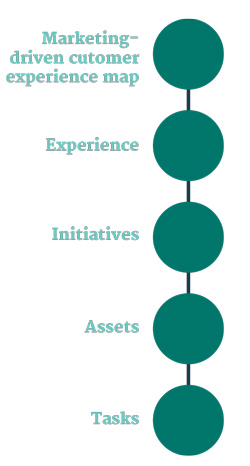
Your marketing-driven customer experience map is your high-level view of what’s happening across the entire customer experience. It’s made up of multiple experiences, which are sets of assets with the shared goal of moving customers along in the life cycle. Initiatives are groups of assets produced in a certain body of work in a certain time period. The assets themselves define each customer interaction across the customer life cycle, whether the interaction is a blog post, sales script, or help article. Last but not least, tasks are the individual assignments that need to be completed by an internal stakeholder by a certain date in order to get an asset produced and distributed (e.g., a task could read: “Jodi to approve email copy by 7/31”).
With proper altitudes of visibility, managers have the ability to see and understand all the moving pieces making a consistent customer experience possible. It also helps identify possible disconnects before they become a problem, or when crucial elements of execution are in danger of getting off-track.
This notion of altitudes of visibility also applies in the reverse. The overall strategic plan from marketing leadership is often lost as it’s funneled down to the front-line contributors. But with proper altitudes of visibility, a contributor can zoom out from their individual task to the wider asset, campaign, experience, and customer experience map to see just how their part fits into the bigger picture.
Phase 3: Alignment
During this stage, the goal is to eliminate misaligned efforts, both internally and externally. Internally, different teams work within disparate tools and processes, and struggle to communicate plans, share insights, and collaborate effectively. Also, without established processes, handoffs between teams are painful and sloppy, and important items fall through the cracks and cause frustration. This lack of alignment across teams—each creating and sharing inconsistent content through different channels and stages of the funnel—leads to a jarring and disjointed customer experience.
Here’s how to establish alignment across people, initiatives, technology, and channels.
Break Down Silos between Teams
At this point, you’ve already mapped the customer experience and defined the interlock between these experiences. In the very exercise of creating connections between experiences, marketers cut to the root of the customer experience problem: disconnects between marketing silos.
In large, fast-moving organizations, facilitating coordination and integration between disparate teams can be difficult—but it’s necessary, and adopting an experience interlock approach supports this mission.
By its very structure, experience interlock forces marketing organizations to identify disconnects and clarify the role of each functional group.
As marketers chart the pathway through the customer experience map and plan each interlock, functional teams can still operate individually to execute the plan, but they do so as part of a connected customer experience.
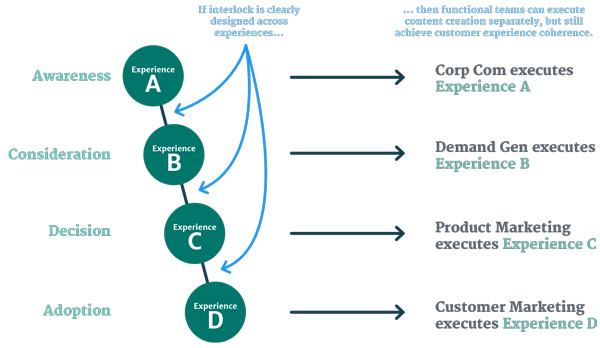
Working under with the strategy for experience interlock also removes the need for spontaneous, asset-by-asset coordination. Instead, disparate teams comply with the broad design illustrated by the customer experience map and experience interlock, and continue to work in their separate teams to create the assets.
This is true in executing particular experiences, and it’s also true for initiatives. As covered earlier, experiences are defined by the external impact on the customer, while initiatives support internal organization and execution. Initiatives focus on specific goals and are executed in a particular timeframe, for example, a product launch. By aligning teams internally around initiatives, it also makes coordination of efforts—and the efficient reuse of content across teams and channels—organic.
Align Marketing Technology and Channels
As discussed at the start of this guide, technology and channels have fractured the customer experience. When different teams use different tools to execute their piece of the marketing strategy, they lose visibility and the ability to collaborate efficiently. This is a huge problem when it comes to delivering an effective customer experience, as it supports a siloed and disconnected approach to execution instead of a cohesive strategy.
The importance of aligning the tools needed to execute your strategy cannot be overstated. Not only does it help to coordinate efforts across teams for more efficient execution, but integrating all the pieces of your marketing technology stack ensures alignment in data and reporting. Without this step, optimization (the fourth phase of delivering an effective customer experience) is a much more challenging step to achieve.
Another outcome of integration is consistency across your marketing channels. When everyone is working from the same tools, visibility is further supported and different teams can deliver interlocked marketing experiences and cohesive content through every marketing channel, from social to marketing automation to sales channels to customer success teams.
Phase 4: Optimization
Once alignment is achieved, organizations move into the optimization stage. Instead of driving marketing initiatives forward based on instinct or opinion, marketers focus on creating a data-driven customer experience. With a systematic operation in place, internal processes can continuously improve and scale for global collaboration and alignment. Furthermore, with tools aligned, data on every stage of the customer lifecycle (full-funnel metrics) can be pulled from across teams and technologies, allowing for constant improvements to the customer experience.
Measuring Engagements across Experiences
Once experiences have been mapped and content has been aligned across the customer journey, the first step to optimization is to review engagement, reach, and conversion metrics. Do this for every experience in your customer experience map. This won’t yet give you insight into interlock (we’ll get to that later), but it will help you understand which experiences currently reach your customers and drive performance.
Reach is a difficult metric to define because how you calculate it (impressions, engagement, etc.) will often vary from channel to channel and system to system. But what’s important to calculate is how content creates an engagement (e.g., a click, a view, a share, a download, an email open) across the channels and tools used to reach buyers. Look at reach for each experience, then slice and dice the data by channel, responsible team, and specific content assets.
To help you visualize the impact of these engagements, consider the customer experience map below, in which the size of the circle represents the number of engagements that the assets of a specific experience generate over a time period—say the last 12 months. The bigger the circle, the more touches a specific experience generated.
Such a map provides a visualization of engagement per experience and stage:
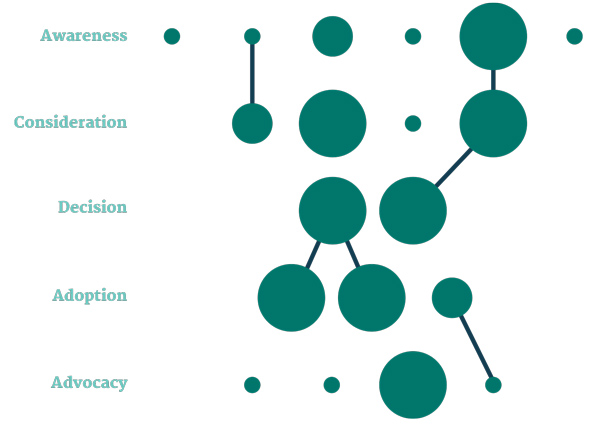
Normally, we’d expect the touch count at the top of the funnel to be greater than toward the bottom, since companies typically have more leads than new customers. But in this example, the model shows that touch counts for top-of-funnel experiences are comparatively low.
This reveals that experiences at the awareness stage need an overhaul, as they aren’t resulting in touches. Perhaps the content in these current experiences consists of archaic, product-centric pieces like press releases or product announcements instead of compelling, customer-centric assets.
Furthermore, these new experiences can be designed so the conclusions at the awareness stage connect to the questions at the consideration stage. This experience interlock will improve awareness-to-consideration conversion.
Addressing the gaps shown in the map—poor-performing awareness experiences and poor awareness-to-consideration interlock—should be the top priority for marketers to optimize the experience moving forward.
Measuring Content Score across Experiences
Once you have a sense of which experiences drive engagements, review the actual impact on business growth. Use conversion metrics to understand how impactful your current experiences are at driving conversions from one stage of the funnel to the next. This is critical to ultimately understanding interlock, and strategizing the paths you create from one experience to the next.
To understand these conversions, track the content score by experience. The content score is essentially an attribution model for the leads, opportunities, and revenue at each stage of their pipeline. For instance, if your pipeline is made up four stages (marketing-qualified leads, sales-accepted leads, closed deals, and upsell), track the experiences that have generated the most conversions for each of these stages. This allows you to optimize future content based on what converts within your pipeline, not just above the pipeline. As with engagement metrics, this data should also be evaluated by channel, team, stage, and content asset to provide the complete picture.
One way to think about this is by using the visualization below, where the size of the experience node represents the content score:
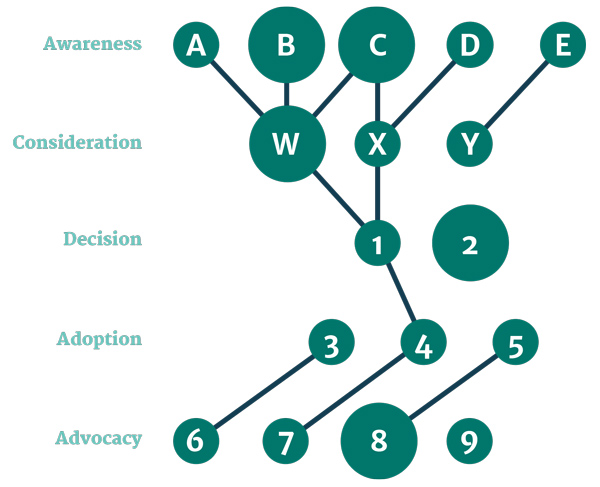
In this example, of the new experiences at the awareness stage, B and C perform extremely well, while A is a dud. With these insights, customer experience strategy can be shaped by the knowledge that topics in B and C attract prospective customers and lead them into the funnel, while the topics in A do not.
Now, consider another customer experience map visualization. In this diagram, the weight of the interlock between experiences indicates the frequency prospects travel from that specific path from experience to experience:
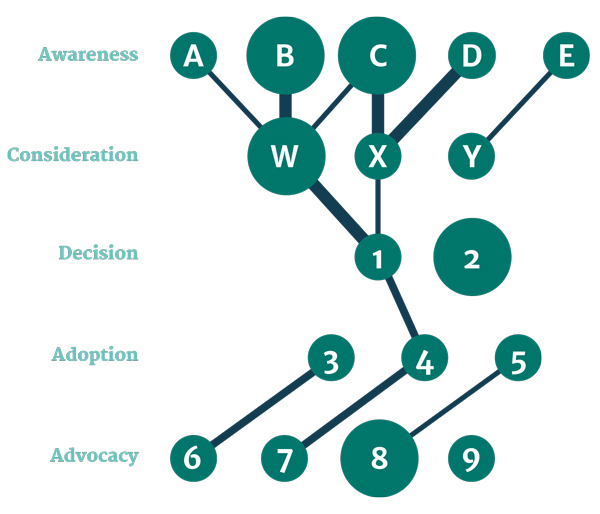
Of the two highest-performing experiences, B shows good transitions—and thus, good interlock—with W. C is shows good interlock with X.
The interlock planned between C and W is not manifesting, indicating that the conclusions of C don’t connect with the questions of W. This is a problem, because X is also not transitioning well to the decision stage. We therefore have a potential dead end at experience X. With this information, marketers can continue to optimize the customer experience.
Looking Ahead: Growing Expectations for Marketers
Getting to this level of optimization takes time, and is impossible without first building a strong foundation for visibility and alignment. But measuring success of the customer experience is critical for B2B marketers today, and as marketing takes ownership of the full customer journey, those expectations will only get larger.
B2B marketing leaders are increasingly responsible for managing all phases—planning, creation, distribution, and analysis—of their customer experience, and must prepare for shifts in the way success is tracked. These areas of customer experience management are identified by analysts as the greatest challenge facing marketing leaders going forward. In “Predictions 2016: B2B Marketing’s New Mission” (Forrester Research, Inc., November 13, 2015), Forrester analysts assert:
With no single function accountable for creating a consistent flow of interactions across the buyer’s lifetime, B2B firms that deliver a patchwork quilt of experiences will lose out to more customer-obsessed competitors. 2016 is the year when B2B marketing will adopt an omnichannel orientation. …
B2B marketing leaders need to lead this transformation from the role of top-notch supplier of leads and collateral for the load-bearing sales channel to the architect of full customer engagement. Marketing success measurement will change to metrics like retention/renewal rates (now mostly a performance metric for the sales function), customer deal close time, customer lifetime value, and even customer experience.
Marketing leaders’ success will be measured by their stewardship of the customer experience, their ability to design “full customer engagement” across all channels and the full life cycle.
This guide has examined the steps B2B marketers must take now to deliver effective customer experiences across technologies, channels, people, and initiatives.

